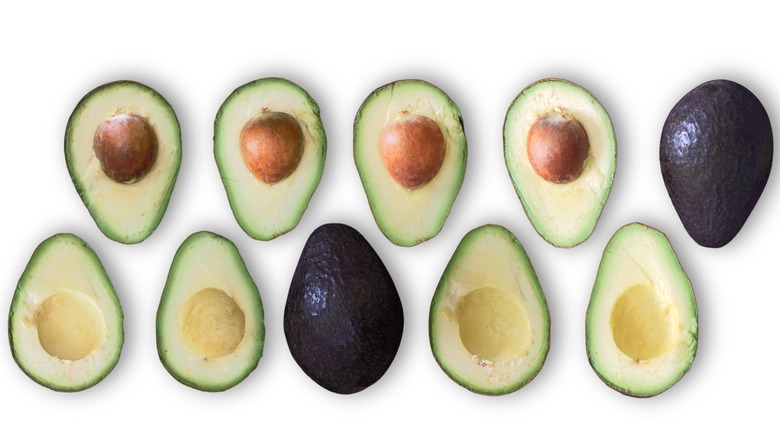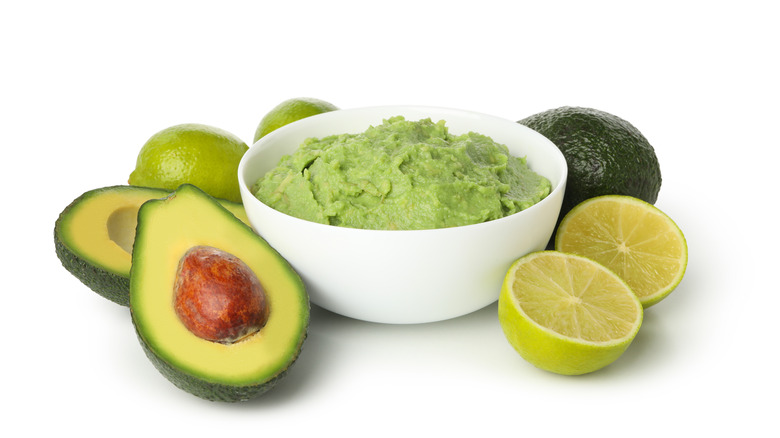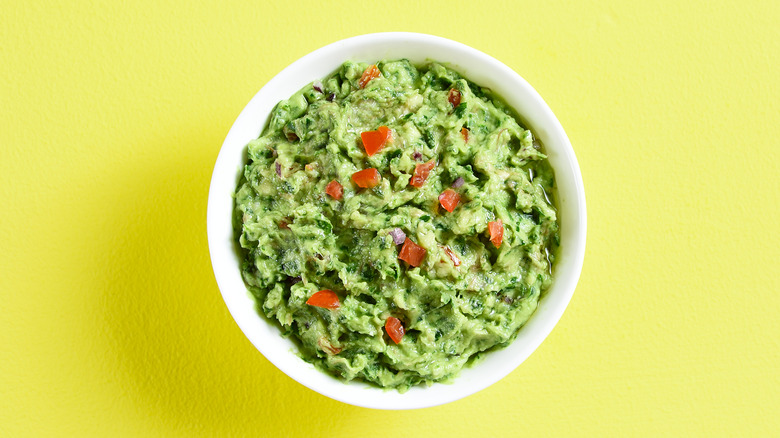Avocado Salsa Versus Guacamole: What's The Difference?
You can't spell "avocado" without "do" — as in, "yes, I think I'll have another avocado, thank you." According to fruit purveyor Avocados From Mexico, the average U.S. consumer eats eight pounds of avocados exported from Mexico every year — making for 81 million pounds of avocados annually consumed nationwide, via the South Florida Reporter. According to the Colorado Integrated Food Safety Center of Excellence, roughly 400 million pounds are harvested each year in California alone, and California is only the world's second-largest producer of avocados after Mexico. Folks worldwide can't get enough of the fruit — and for good reason, too.
Avocados are packed with healthy fats (as per Avocados From Mexico's legendary 2017 Super Bowl commercial). Monounsaturated fats (like omega-9 fatty acid oleic, which avocados are full of) are heart-healthy fats that can reduce inflammation and even lower bad LDL cholesterol levels, explains WebMD. Per Medical News Today, avocados can also improve digestion, boost serotonin, and decrease cancer risk. Plus, just half an avocado packs 10% of the daily recommended value for potassium (via Healthline).
Luckily, from simple avocado toast to this luxurious $85 grilled avocado, there are plenty of ways to incorporate the delicious and nutrition-packed fruit into your diet. But, avo-fans still have one question: avocado salsa versus guacamole — what's the difference?
Add a dollop of avocado salsa
Simply put, avocado salsa is salsa with a heavier emphasis on avocado than traditional tomato. Avocado salsa is often made from a combination of avocado, garlic, cilantro, lime juice, and finely diced red tomatoes, according to Cooking Classy. But, there's a healthy degree of variation from recipe to recipe — this avocado salsa from Tostitos includes crushed green tomatoes, jalapeno peppers, onions, and red bell peppers. Avocado salsa can be a transformative condiment on everything from tortilla chips, to seafood, to dolloped over fresh mangos. Superfans could even add a spoonful of avocado salsa to spice up your avocado toast.
The key differences between avocado salsa and guacamole, as Boss the Kitchen notes, are that avocado salsa is much thinner and includes an important key ingredient: tomatillos. According to Delish, tomatillos (also known as husk tomatoes per Boss the Kitchen) are small, firm, tart fruits native to Mexico and Central America that resemble unripe green tomatoes in texture and flavor profile. Avocado salsa is actually a version of salsa verde, of which tomatillos are also the chief ingredient, says PepperScale. Salsa verde, which directly translates to "green sauce," is a tart, spicy sauce based on tomatillos and varying amounts of chili pepper. Long story short: avocado salsa functions more as a condiment than a dip.
Scoop up that guacamole
Guacamole is a smooth avocado-based dip, often purred, more comparable to a creamy hummus or a savory mousse than a traditional finely-diced salsa. Like avocado salsa, guacamole also contains ingredients cilantro, lime juice, onion, and diced tomatoes (via Spoon University), but the difference between the two is all about texture.
According to Pan-Asian Latin Fusion restaurant Casa Sensei, it's speculated that guacamole was first invented by the Aztecs as far back as 500 B.C. In fact, it says, the Aztecs were already making guacamole by the time the Spaniards landed and brought the green dip recipe back to Europe.
Today, guacamole is commonly eaten as part of Cinco de Mayo celebrations (via NBC), or perhaps most commonly, a small bowl of guacamole might come out with the basket of tortilla chips at your favorite Mexican restaurant. But, guacamole can also be served with nachos, in tacos or burritos, or as a salad dressing. For an unexpected twist, you can add a dollop on top of your next smoked salmon filet. You can even use guacamole as a face mask, like this one from Pacifica. It's also good right from the spoon.


